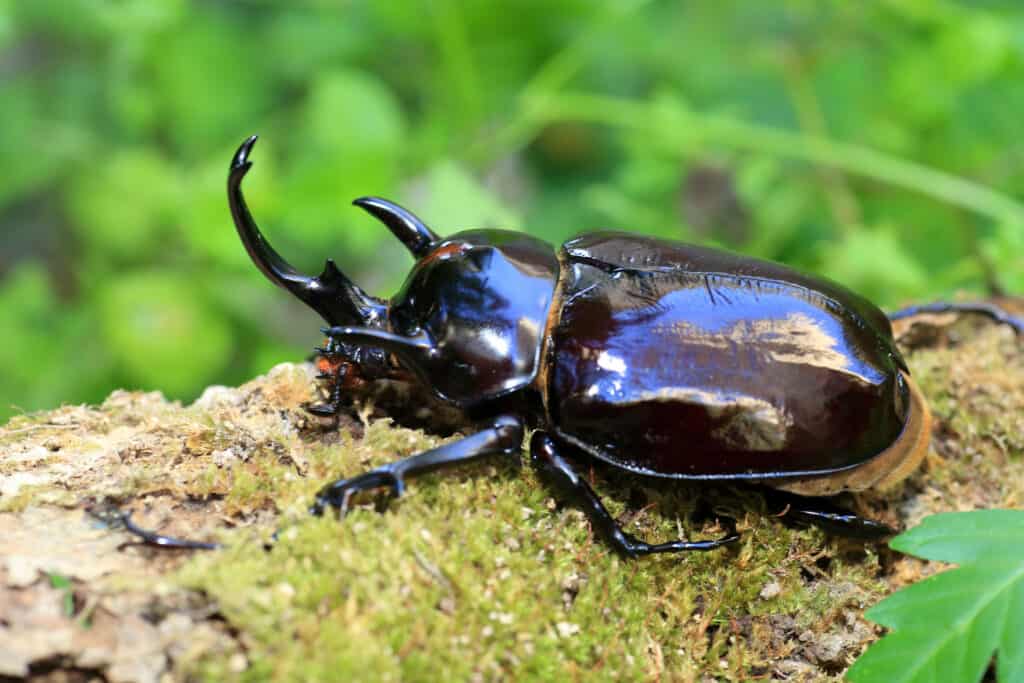Elephant Beetle
Megasoma elephas
The males have multiple horns at the front of their bodies.
Advertisement
Elephant Beetle Scientific Classification
- Kingdom
- Animalia
- Phylum
- Arthropoda
- Class
- Insecta
- Order
- Coleoptera
- Family
- Scarabaeidae
- Genus
- Megasoma
- Scientific Name
- Megasoma elephas
Read our Complete Guide to Classification of Animals.
Elephant Beetle Conservation Status
Elephant Beetle Facts
- Name Of Young
- Larvae
- Group Behavior
- Solitary
- Fun Fact
- The males have multiple horns at the front of their bodies.
- Biggest Threat
- Destruction of habitat
- Most Distinctive Feature
- Horns on male Elephant Beetles
- Distinctive Feature
- Hard front wings called elytra
- Gestation Period
- 2-3 weeks
- Habitat
- Tropical rainforest in Mexico, Central America, South America
- Diet
- Herbivore
- Lifestyle
- Diurnal/Nocturnal
- Favorite Food
- Sap of plants and decaying plants
- Number Of Species
- 1
- Location
- Mexico, Central America, South America
- Nesting Location
- Fallen logs
Elephant Beetle Physical Characteristics
- Color
- Yellow
- Black
- Skin Type
- Shell
- Lifespan
- Up to 3 years
- Weight
- Up to 100 grams
- Length
- 7-12 inches
- Age of Sexual Maturity
- Around 3 years
- Venomous
- No
- Aggression
- Low
View all of the Elephant Beetle images!
It may not be as big as an elephant or have a trunk, but the Elephant Beetle shares some interesting features with its namesake.
While these beetles are not as big as elephants (or even the largest beetle in the animal kingdom), their size sure makes them an interesting specimen to study. The males have tell-tale horns that also led to their name, Elephant Beetle. Just like elephants, male Elephant Beetles use their horns to compete for food and mates, showing their dominance with displays of power.
Facts
- Male Elephant Beetles have multiple horns that they use to show their dominance. While they do not use these to injure or kill, the males still fight over food and mates. These horns also come in handy to dig for food or protection.
- Elephant Beetles are some of the largest beetles and can grow up to 12 centimeters long. The males are generally larger than the females.
- These beetles have four life stages: egg, larvae, pupae, and adult Elephant Beetle. They spend most of their lives in the larvae stage.
- Elephant Beetles are black but have yellow hair that gives them a yellowish-black appearance.
- The hair of the Elephant Beetle is thickest on their elytra, the hard shell of their front wings.
Species, Type, and Scientific Name
The Elephant Beetle is known by the scientific name Megasoma elephas. The Megasoma genus includes rhinoceros beetles. The word Megasoma means “large body” in Greek, which hints at the larger than average size of most beetles in this genus. Elephant Beetles belong to the Scarabaeidae family, also known as scarabs or scarab beetles. There are more than 30,000 members of the Scarabaeidae family and all are characterized by hard front wings.
All beetles, including the Elephant Beetle, are part of the Coleoptera order. There are over 400,000 species of beetles. The entire order makes up around a quarter of the known animal species on earth. Elephant Beetles are part of the Insecta class, Arthropoda phylum, and Animalia kingdom.
Appearance: How to Identify Elephant Beetles
Even though the term Elephant Beetle can be used to describe other species within the Megasoma genus, it most accurately refers to the Megasoma elephas. True to its name, the Elephant Beetle is large and can grow to be up to 12 centimeters long. The males are typically larger than the females. Overall, their size ranges from 7 to 12 centimeters.
Another reason that Elephant Beetles get their name is that they have “horns” on the front of their head. The front horn is large and extends out from the very front of their body, with a split upper horn just above. There are also two smaller horns further back. Only males have these projections, which makes them easier to identify.
What are these horns used for? The males don’t fight each other with the intent to injure or kill, but they do use their horns to show their dominance over other males and the push them away from food and potential mates.
Elephant Beetles are black. But, due to the yellowish hair that covers their bodies and wings, they have a yellowish-black appearance at first glance. The first thing you’ll notice about a male Elephant Beetle is likely its horns, while a female Elephant Beetle is best identified by its smaller size and coloring.

Note the distinctive horns on the Elephant Beetle. Only the males have these horns.
©feathercollector/Shutterstock.com
Habitat: Where to Find Elephant Beetles
The Megasoma elephas is found in Central and South America. They can also be seen in the most Southern parts of Mexico. These parts of the world are rich in food for Elephant Beetles. They favor tropical rain forests with plenty of plants to eat and logs in which to lay their eggs.
Other species within the genus and family are located in Europe and North America. They are sometimes referred to as Elephant Beetles, especially other species within the Megasoma genus.
Diet: What Do They Eat?
Elephant Beetles are herbivores and eat plants and sap in their environment. Sap moves water and nutrients around the plant to its branches, leaves, and fruit. Elephant Beetles feed on this nutrient-rich sap as adults. They have also been observed eating some fruit and even bark. Because they live in the tropical rainforest, most of their preferred food sources are tropical fruits and plants.
When reproducing, Elephant Beetles lay their eggs in fallen logs. After 2-3 weeks, the eggs hatch and become larvae that feed on the decaying wood where they were born. They stay this way for almost 3 years, feeding on fallen leaves, logs, fruit, and other plants on the ground. They eventually become pupae and then adult Elephant Beetles.
Elephant Beetles spend most of their lives as larvae. They become pupae for only a few months and then turn into mature Elephant Beetles. The females lay their eggs and the circle begins all over again.
Prevention: How to Get Rid of Elephant Beetles
While not nocturnal, these insects are more active at night. This can make it difficult to find out if Elephant Beetles are causing problems unless you are actively looking for them. Fortunately, Elephant Beetles rarely cause problems. In fact, they are actually good for the environment because they eat decaying plant matter and make room for new plants to grow.
In their larvae stage, Elephant Beetles mostly eat dead and decaying plants. These can include leaves and fruit as well as larger items like logs and branches. This is a helpful and vital part of the ecosystem in their natural environments. They take care of clearing debris from the forest floor. The larvae can also be food for other species in their environment. As larvae, they are white with small legs and do not yet have the protection from the hard front wings that they will have as adults.
When Elephant Beetles are introduced to new areas, however, their feeding habits may cause damage to the existing ecosystem. Other species of beetles rely on the same food sources and too much competition can lead to population numbers dwindling. Fortunately, the Megasoma elephas species is not invasive or harmful. Other species within the genus or family, however, are considered invasive. For example, the Coconut Rhinoceros Beetle is invasive in Hawaii and can cause damage to native plants including coconut palms and African oil palms.
Protecting Elephant Beetles
Due to the destruction of their rain forest habitat, there is some concern for Elephant Beetles. They are not listed as endangered, but it is still a good idea to take care to preserve their natural environment. Elephant Beetles spend the majority of their lives as larvae, which means they are less protected and do not yet have the hard outer shell of their elytra.
Similar Insects to Elephant Beetles
- Scarab Beetles: Elephant Beetles are a type of scarab. But with over 30,000 species, these beetles are very diverse. The most well-known scarab is one that the ancient Egyptians worshipped, the Scarabaeus sacer.
- Hercules Beetle: This is another large species of beetle and another member of the Scarabaeidae family. Male Hercules Beetles also have horns, similar to the Elephant Beetle. These beetles can grow up to 3 inches long or more.
Elephant Beetle FAQs (Frequently Asked Questions)
Is an Elephant Beetle poisonous?
No, an Elephant Beetle is not aggressive or poisonous. If it does wave its horn in your direction, it is just a show of force. Elephant Beetles do not use their horns to injure and do not eat anything other than plants.
How long does an Elephant Beetle live?
Elephant Beetles can live up to 3 years. They spend most of this time in the larvae stage and only mature for the last few months of their lives.
How much does an Elephant Beetle weigh?
These beetles are large and can weigh up to 100 grams as adults. They grow to be between 7 and 12 centimeters long. The males are typically heavier and longer than the females.
Thank you for reading! Have some feedback for us? Contact the AZ Animals editorial team.
Sources
- Britannica, Rhinoceros Beetle / Accessed September 20, 2022
- Hawaii Invasive Species Council / Accessed September 20, 2022
- Howler Magazine / Accessed September 20, 2022















